HI5020 Corporate Accounting: Analysis of Amcor Limited's Finances
VerifiedAdded on 2024/06/03
|15
|2588
|64
Report
AI Summary
This report provides a comprehensive financial analysis of Amcor Limited, focusing on key financial statements such as the cash flow statement and other comprehensive income statement. It examines operating, investing, and financing activities, highlighting significant changes in these areas. The report also delves into accounting for corporate income tax, discussing tax expenses, deferred tax assets and liabilities, and the differences between income tax expense and income tax paid. The analysis includes a review of Amcor's tax rate, accounting income, and the impact of various adjustments on taxable income. This detailed assessment offers insights into Amcor's financial health and tax management strategies, with all the information sourced from the company's annual reports. Desklib provides students access to past papers and solved assignments.
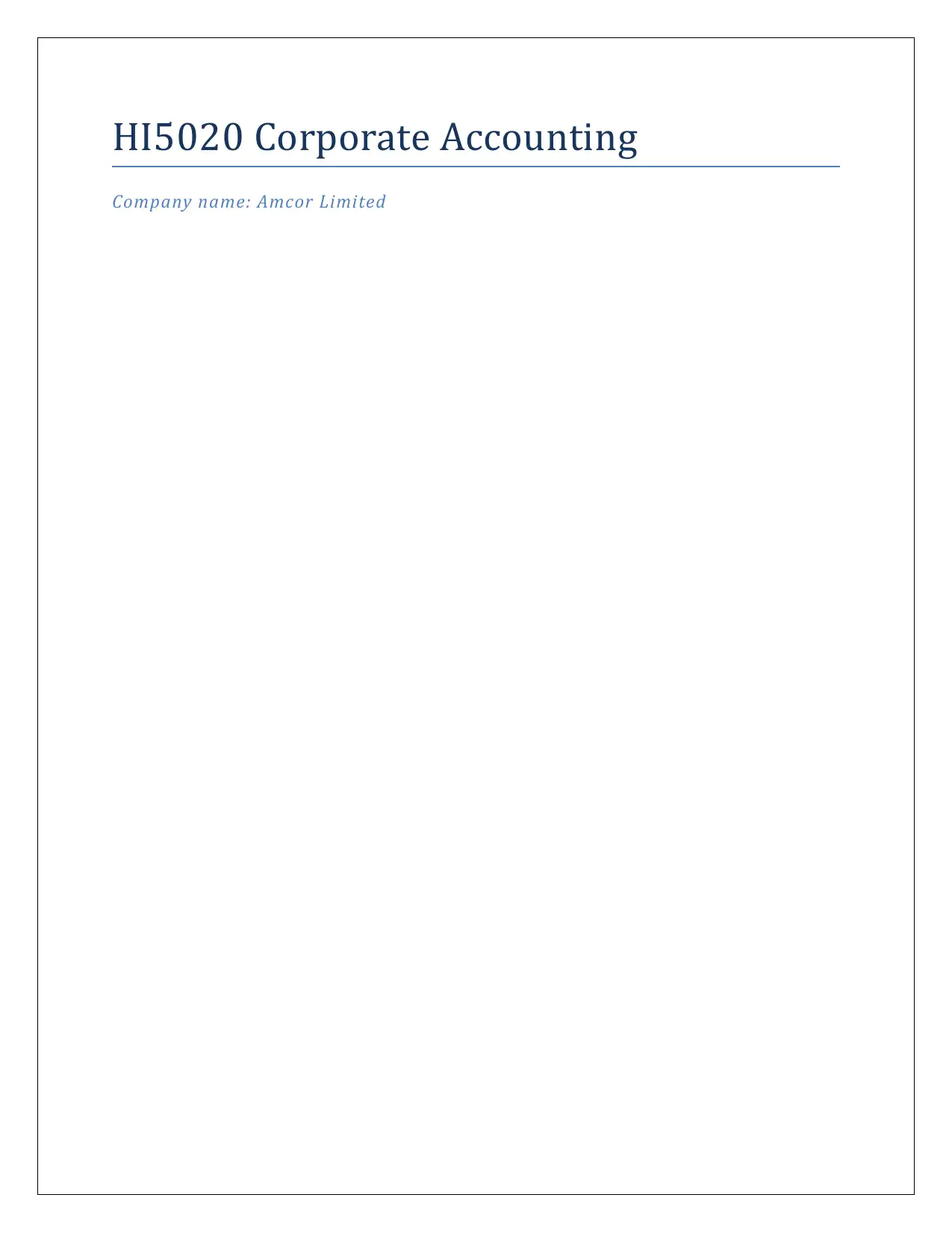
HI5020 Corporate Accounting
Company name: Amcor Limited
Company name: Amcor Limited
Paraphrase This Document
Need a fresh take? Get an instant paraphrase of this document with our AI Paraphraser
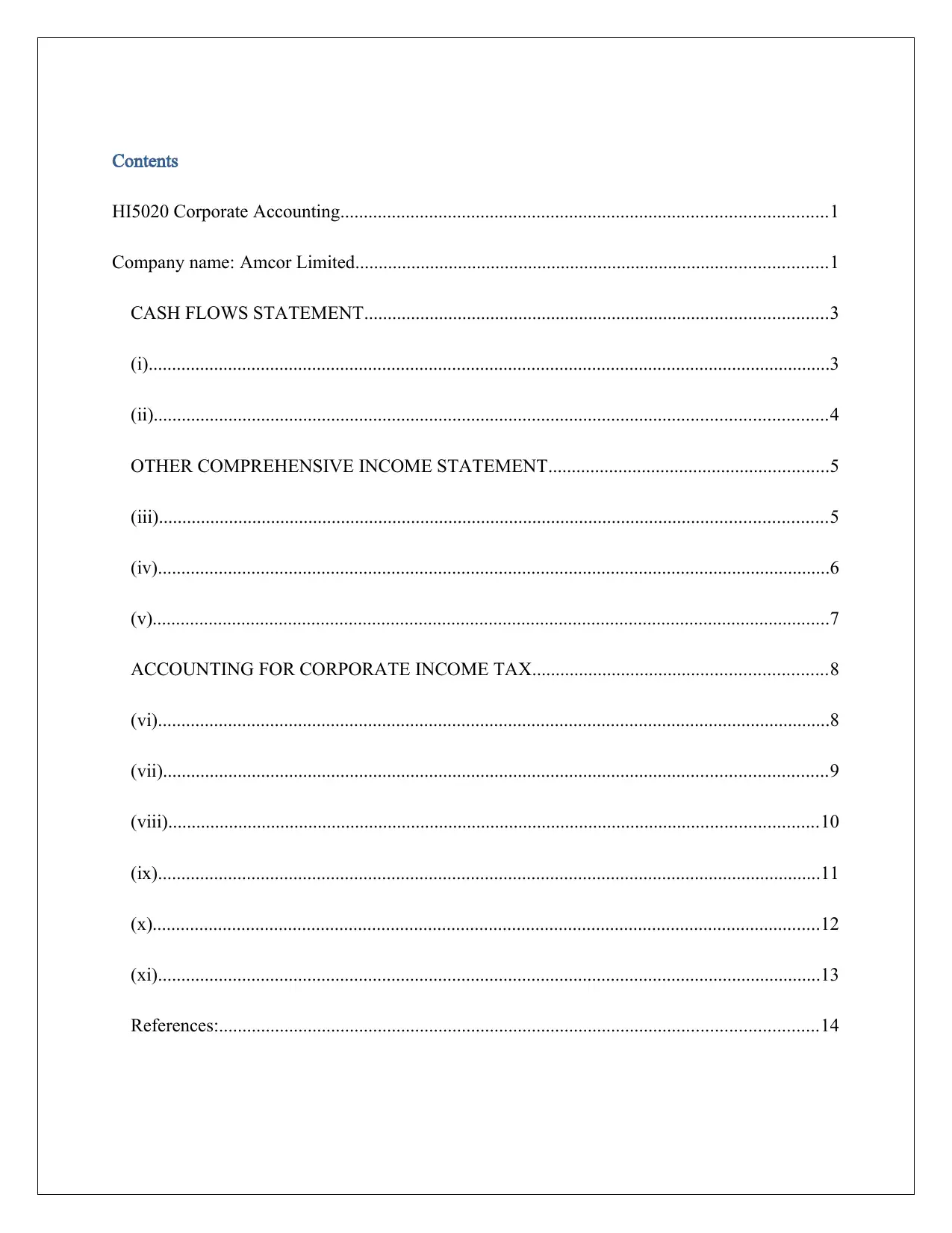
Contents
HI5020 Corporate Accounting........................................................................................................1
Company name: Amcor Limited.....................................................................................................1
CASH FLOWS STATEMENT...................................................................................................3
(i)..................................................................................................................................................3
(ii)................................................................................................................................................4
OTHER COMPREHENSIVE INCOME STATEMENT............................................................5
(iii)...............................................................................................................................................5
(iv)................................................................................................................................................6
(v).................................................................................................................................................7
ACCOUNTING FOR CORPORATE INCOME TAX...............................................................8
(vi)................................................................................................................................................8
(vii)..............................................................................................................................................9
(viii)...........................................................................................................................................10
(ix)..............................................................................................................................................11
(x)...............................................................................................................................................12
(xi)..............................................................................................................................................13
References:................................................................................................................................14
HI5020 Corporate Accounting........................................................................................................1
Company name: Amcor Limited.....................................................................................................1
CASH FLOWS STATEMENT...................................................................................................3
(i)..................................................................................................................................................3
(ii)................................................................................................................................................4
OTHER COMPREHENSIVE INCOME STATEMENT............................................................5
(iii)...............................................................................................................................................5
(iv)................................................................................................................................................6
(v).................................................................................................................................................7
ACCOUNTING FOR CORPORATE INCOME TAX...............................................................8
(vi)................................................................................................................................................8
(vii)..............................................................................................................................................9
(viii)...........................................................................................................................................10
(ix)..............................................................................................................................................11
(x)...............................................................................................................................................12
(xi)..............................................................................................................................................13
References:................................................................................................................................14
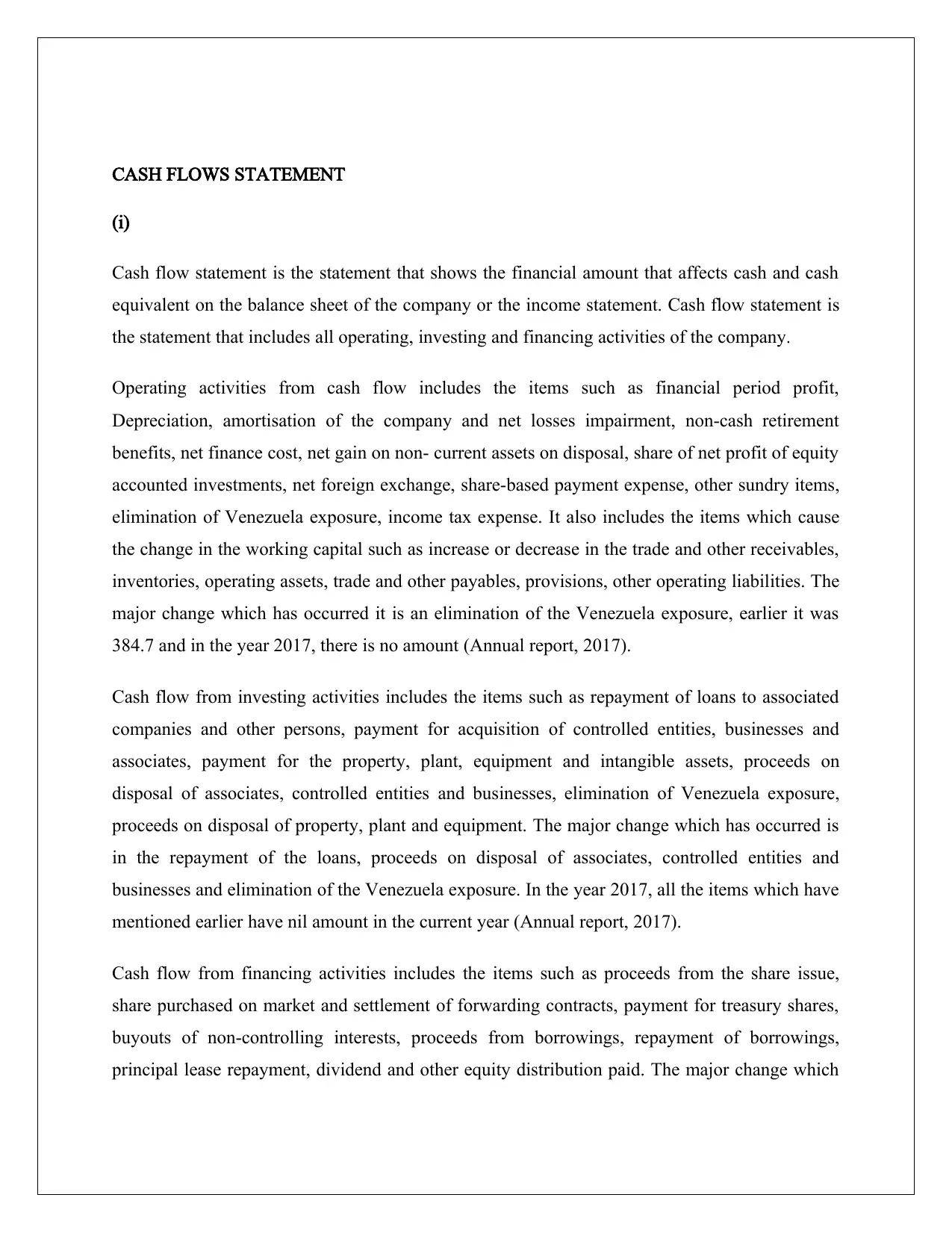
CASH FLOWS STATEMENT
(i)
Cash flow statement is the statement that shows the financial amount that affects cash and cash
equivalent on the balance sheet of the company or the income statement. Cash flow statement is
the statement that includes all operating, investing and financing activities of the company.
Operating activities from cash flow includes the items such as financial period profit,
Depreciation, amortisation of the company and net losses impairment, non-cash retirement
benefits, net finance cost, net gain on non- current assets on disposal, share of net profit of equity
accounted investments, net foreign exchange, share-based payment expense, other sundry items,
elimination of Venezuela exposure, income tax expense. It also includes the items which cause
the change in the working capital such as increase or decrease in the trade and other receivables,
inventories, operating assets, trade and other payables, provisions, other operating liabilities. The
major change which has occurred it is an elimination of the Venezuela exposure, earlier it was
384.7 and in the year 2017, there is no amount (Annual report, 2017).
Cash flow from investing activities includes the items such as repayment of loans to associated
companies and other persons, payment for acquisition of controlled entities, businesses and
associates, payment for the property, plant, equipment and intangible assets, proceeds on
disposal of associates, controlled entities and businesses, elimination of Venezuela exposure,
proceeds on disposal of property, plant and equipment. The major change which has occurred is
in the repayment of the loans, proceeds on disposal of associates, controlled entities and
businesses and elimination of the Venezuela exposure. In the year 2017, all the items which have
mentioned earlier have nil amount in the current year (Annual report, 2017).
Cash flow from financing activities includes the items such as proceeds from the share issue,
share purchased on market and settlement of forwarding contracts, payment for treasury shares,
buyouts of non-controlling interests, proceeds from borrowings, repayment of borrowings,
principal lease repayment, dividend and other equity distribution paid. The major change which
(i)
Cash flow statement is the statement that shows the financial amount that affects cash and cash
equivalent on the balance sheet of the company or the income statement. Cash flow statement is
the statement that includes all operating, investing and financing activities of the company.
Operating activities from cash flow includes the items such as financial period profit,
Depreciation, amortisation of the company and net losses impairment, non-cash retirement
benefits, net finance cost, net gain on non- current assets on disposal, share of net profit of equity
accounted investments, net foreign exchange, share-based payment expense, other sundry items,
elimination of Venezuela exposure, income tax expense. It also includes the items which cause
the change in the working capital such as increase or decrease in the trade and other receivables,
inventories, operating assets, trade and other payables, provisions, other operating liabilities. The
major change which has occurred it is an elimination of the Venezuela exposure, earlier it was
384.7 and in the year 2017, there is no amount (Annual report, 2017).
Cash flow from investing activities includes the items such as repayment of loans to associated
companies and other persons, payment for acquisition of controlled entities, businesses and
associates, payment for the property, plant, equipment and intangible assets, proceeds on
disposal of associates, controlled entities and businesses, elimination of Venezuela exposure,
proceeds on disposal of property, plant and equipment. The major change which has occurred is
in the repayment of the loans, proceeds on disposal of associates, controlled entities and
businesses and elimination of the Venezuela exposure. In the year 2017, all the items which have
mentioned earlier have nil amount in the current year (Annual report, 2017).
Cash flow from financing activities includes the items such as proceeds from the share issue,
share purchased on market and settlement of forwarding contracts, payment for treasury shares,
buyouts of non-controlling interests, proceeds from borrowings, repayment of borrowings,
principal lease repayment, dividend and other equity distribution paid. The major change which
⊘ This is a preview!⊘
Do you want full access?
Subscribe today to unlock all pages.

Trusted by 1+ million students worldwide

has seen in the financing activity is that buyouts of non-controlling interests have occurred in the
year 2017 which has not been there in the previous year.
year 2017 which has not been there in the previous year.
Paraphrase This Document
Need a fresh take? Get an instant paraphrase of this document with our AI Paraphraser
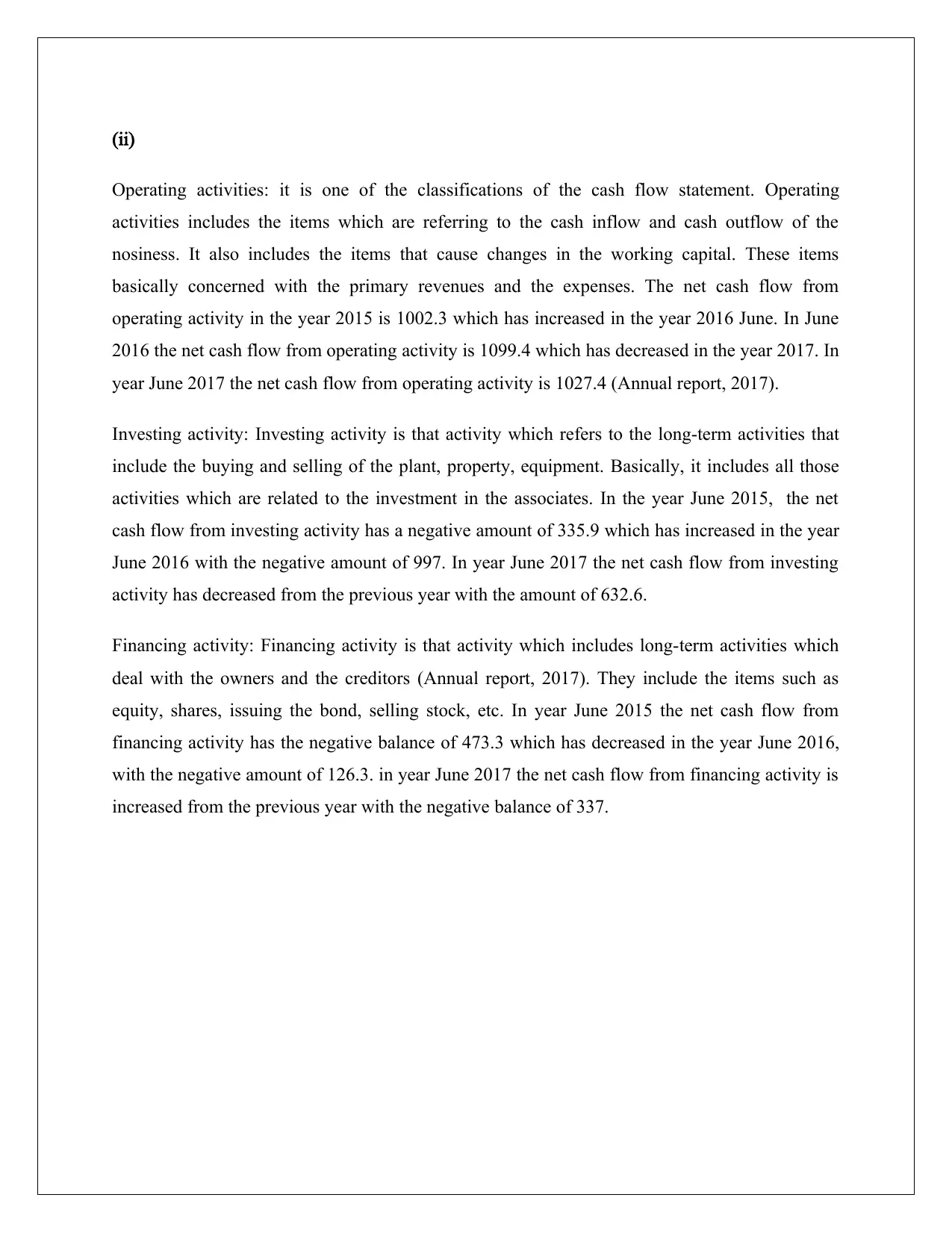
(ii)
Operating activities: it is one of the classifications of the cash flow statement. Operating
activities includes the items which are referring to the cash inflow and cash outflow of the
nosiness. It also includes the items that cause changes in the working capital. These items
basically concerned with the primary revenues and the expenses. The net cash flow from
operating activity in the year 2015 is 1002.3 which has increased in the year 2016 June. In June
2016 the net cash flow from operating activity is 1099.4 which has decreased in the year 2017. In
year June 2017 the net cash flow from operating activity is 1027.4 (Annual report, 2017).
Investing activity: Investing activity is that activity which refers to the long-term activities that
include the buying and selling of the plant, property, equipment. Basically, it includes all those
activities which are related to the investment in the associates. In the year June 2015, the net
cash flow from investing activity has a negative amount of 335.9 which has increased in the year
June 2016 with the negative amount of 997. In year June 2017 the net cash flow from investing
activity has decreased from the previous year with the amount of 632.6.
Financing activity: Financing activity is that activity which includes long-term activities which
deal with the owners and the creditors (Annual report, 2017). They include the items such as
equity, shares, issuing the bond, selling stock, etc. In year June 2015 the net cash flow from
financing activity has the negative balance of 473.3 which has decreased in the year June 2016,
with the negative amount of 126.3. in year June 2017 the net cash flow from financing activity is
increased from the previous year with the negative balance of 337.
Operating activities: it is one of the classifications of the cash flow statement. Operating
activities includes the items which are referring to the cash inflow and cash outflow of the
nosiness. It also includes the items that cause changes in the working capital. These items
basically concerned with the primary revenues and the expenses. The net cash flow from
operating activity in the year 2015 is 1002.3 which has increased in the year 2016 June. In June
2016 the net cash flow from operating activity is 1099.4 which has decreased in the year 2017. In
year June 2017 the net cash flow from operating activity is 1027.4 (Annual report, 2017).
Investing activity: Investing activity is that activity which refers to the long-term activities that
include the buying and selling of the plant, property, equipment. Basically, it includes all those
activities which are related to the investment in the associates. In the year June 2015, the net
cash flow from investing activity has a negative amount of 335.9 which has increased in the year
June 2016 with the negative amount of 997. In year June 2017 the net cash flow from investing
activity has decreased from the previous year with the amount of 632.6.
Financing activity: Financing activity is that activity which includes long-term activities which
deal with the owners and the creditors (Annual report, 2017). They include the items such as
equity, shares, issuing the bond, selling stock, etc. In year June 2015 the net cash flow from
financing activity has the negative balance of 473.3 which has decreased in the year June 2016,
with the negative amount of 126.3. in year June 2017 the net cash flow from financing activity is
increased from the previous year with the negative balance of 337.
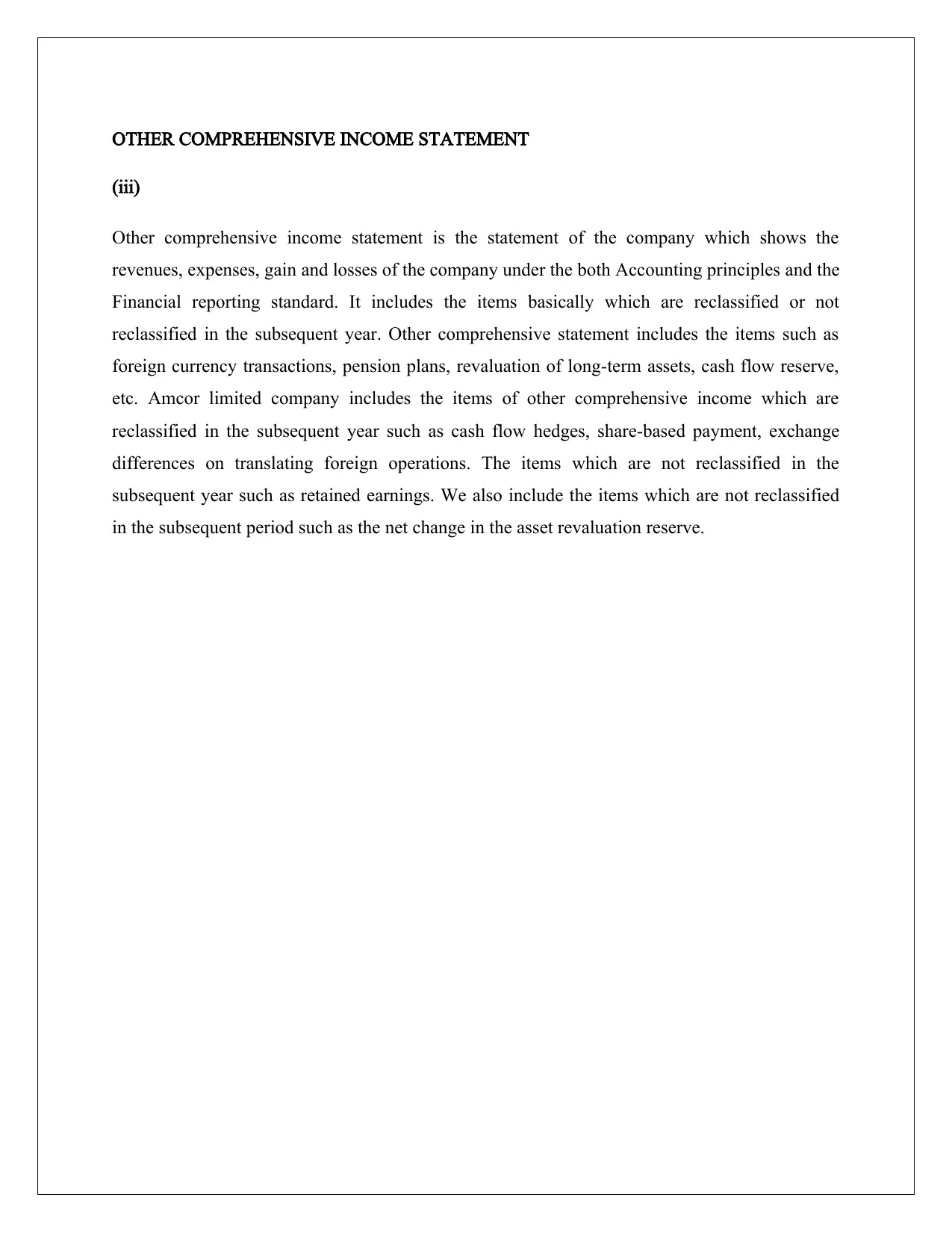
OTHER COMPREHENSIVE INCOME STATEMENT
(iii)
Other comprehensive income statement is the statement of the company which shows the
revenues, expenses, gain and losses of the company under the both Accounting principles and the
Financial reporting standard. It includes the items basically which are reclassified or not
reclassified in the subsequent year. Other comprehensive statement includes the items such as
foreign currency transactions, pension plans, revaluation of long-term assets, cash flow reserve,
etc. Amcor limited company includes the items of other comprehensive income which are
reclassified in the subsequent year such as cash flow hedges, share-based payment, exchange
differences on translating foreign operations. The items which are not reclassified in the
subsequent year such as retained earnings. We also include the items which are not reclassified
in the subsequent period such as the net change in the asset revaluation reserve.
(iii)
Other comprehensive income statement is the statement of the company which shows the
revenues, expenses, gain and losses of the company under the both Accounting principles and the
Financial reporting standard. It includes the items basically which are reclassified or not
reclassified in the subsequent year. Other comprehensive statement includes the items such as
foreign currency transactions, pension plans, revaluation of long-term assets, cash flow reserve,
etc. Amcor limited company includes the items of other comprehensive income which are
reclassified in the subsequent year such as cash flow hedges, share-based payment, exchange
differences on translating foreign operations. The items which are not reclassified in the
subsequent year such as retained earnings. We also include the items which are not reclassified
in the subsequent period such as the net change in the asset revaluation reserve.
⊘ This is a preview!⊘
Do you want full access?
Subscribe today to unlock all pages.

Trusted by 1+ million students worldwide
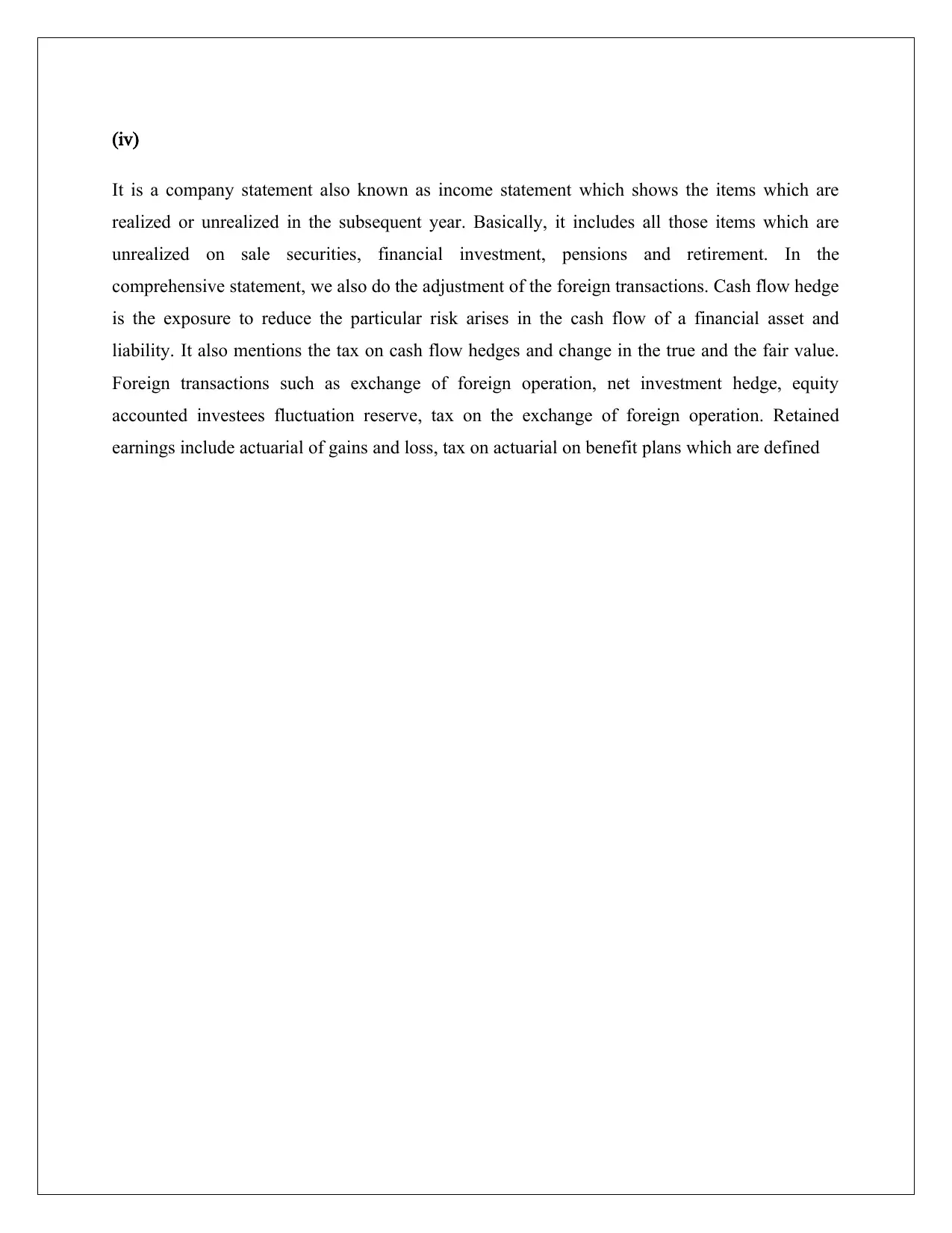
(iv)
It is a company statement also known as income statement which shows the items which are
realized or unrealized in the subsequent year. Basically, it includes all those items which are
unrealized on sale securities, financial investment, pensions and retirement. In the
comprehensive statement, we also do the adjustment of the foreign transactions. Cash flow hedge
is the exposure to reduce the particular risk arises in the cash flow of a financial asset and
liability. It also mentions the tax on cash flow hedges and change in the true and the fair value.
Foreign transactions such as exchange of foreign operation, net investment hedge, equity
accounted investees fluctuation reserve, tax on the exchange of foreign operation. Retained
earnings include actuarial of gains and loss, tax on actuarial on benefit plans which are defined
It is a company statement also known as income statement which shows the items which are
realized or unrealized in the subsequent year. Basically, it includes all those items which are
unrealized on sale securities, financial investment, pensions and retirement. In the
comprehensive statement, we also do the adjustment of the foreign transactions. Cash flow hedge
is the exposure to reduce the particular risk arises in the cash flow of a financial asset and
liability. It also mentions the tax on cash flow hedges and change in the true and the fair value.
Foreign transactions such as exchange of foreign operation, net investment hedge, equity
accounted investees fluctuation reserve, tax on the exchange of foreign operation. Retained
earnings include actuarial of gains and loss, tax on actuarial on benefit plans which are defined
Paraphrase This Document
Need a fresh take? Get an instant paraphrase of this document with our AI Paraphraser
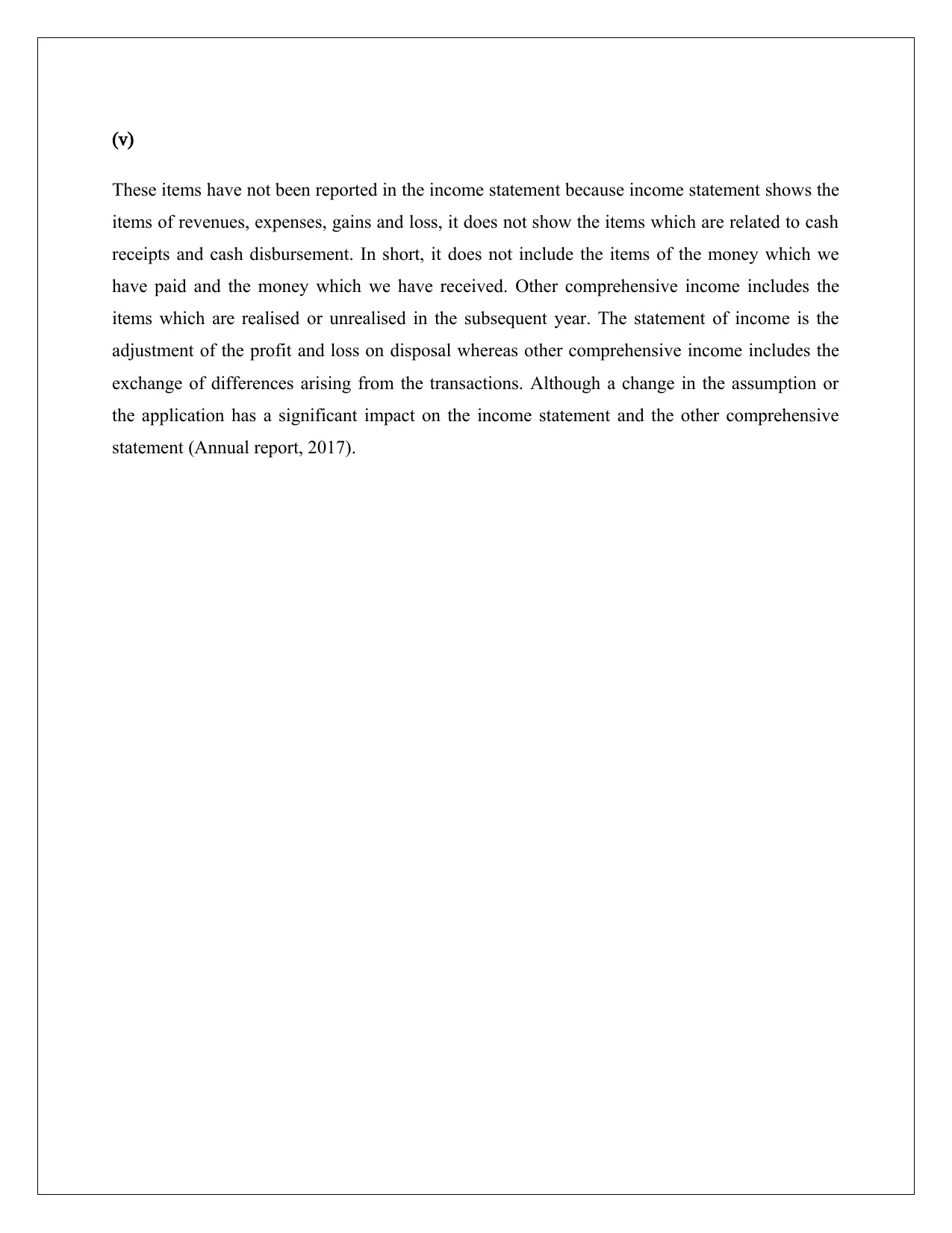
(v)
These items have not been reported in the income statement because income statement shows the
items of revenues, expenses, gains and loss, it does not show the items which are related to cash
receipts and cash disbursement. In short, it does not include the items of the money which we
have paid and the money which we have received. Other comprehensive income includes the
items which are realised or unrealised in the subsequent year. The statement of income is the
adjustment of the profit and loss on disposal whereas other comprehensive income includes the
exchange of differences arising from the transactions. Although a change in the assumption or
the application has a significant impact on the income statement and the other comprehensive
statement (Annual report, 2017).
These items have not been reported in the income statement because income statement shows the
items of revenues, expenses, gains and loss, it does not show the items which are related to cash
receipts and cash disbursement. In short, it does not include the items of the money which we
have paid and the money which we have received. Other comprehensive income includes the
items which are realised or unrealised in the subsequent year. The statement of income is the
adjustment of the profit and loss on disposal whereas other comprehensive income includes the
exchange of differences arising from the transactions. Although a change in the assumption or
the application has a significant impact on the income statement and the other comprehensive
statement (Annual report, 2017).
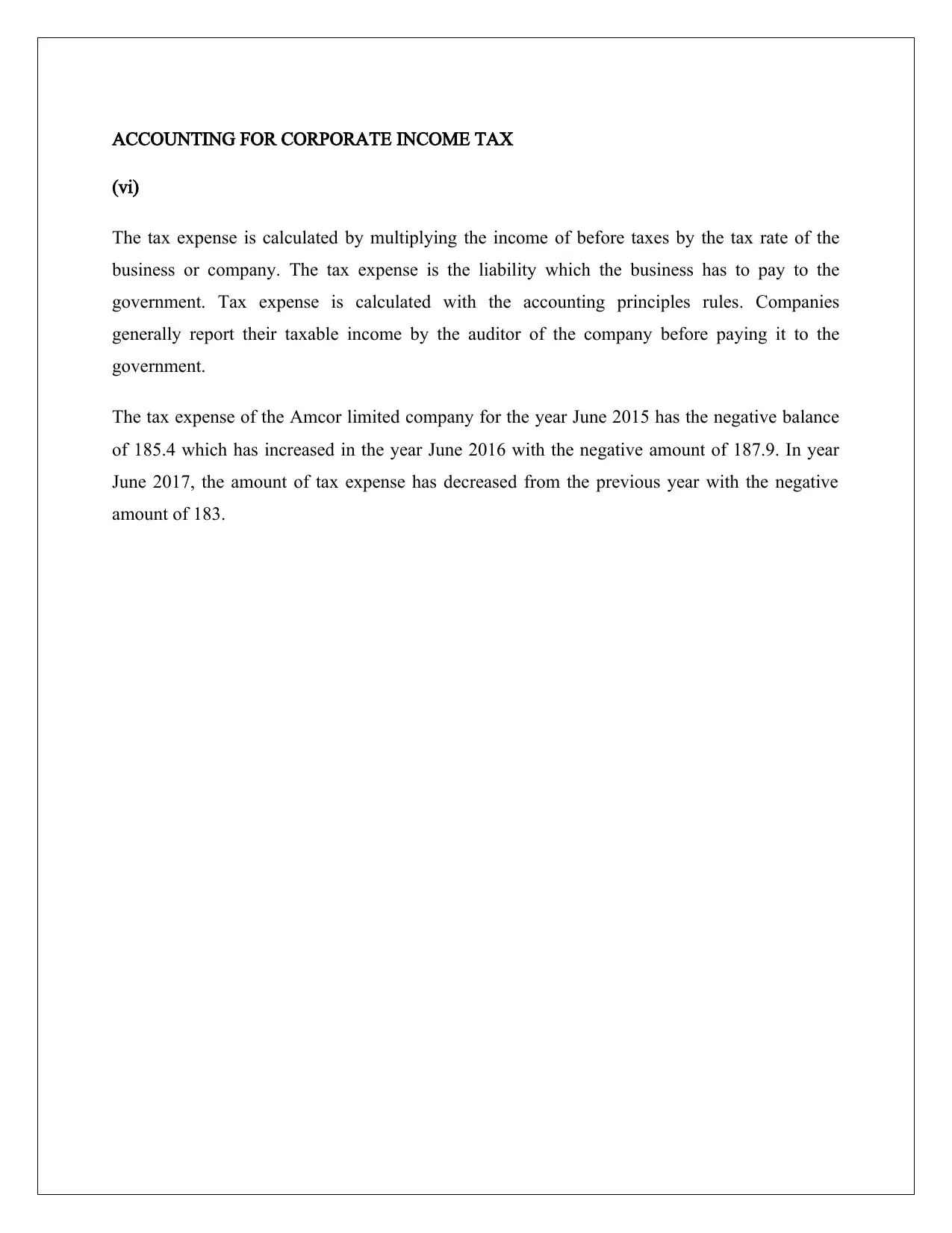
ACCOUNTING FOR CORPORATE INCOME TAX
(vi)
The tax expense is calculated by multiplying the income of before taxes by the tax rate of the
business or company. The tax expense is the liability which the business has to pay to the
government. Tax expense is calculated with the accounting principles rules. Companies
generally report their taxable income by the auditor of the company before paying it to the
government.
The tax expense of the Amcor limited company for the year June 2015 has the negative balance
of 185.4 which has increased in the year June 2016 with the negative amount of 187.9. In year
June 2017, the amount of tax expense has decreased from the previous year with the negative
amount of 183.
(vi)
The tax expense is calculated by multiplying the income of before taxes by the tax rate of the
business or company. The tax expense is the liability which the business has to pay to the
government. Tax expense is calculated with the accounting principles rules. Companies
generally report their taxable income by the auditor of the company before paying it to the
government.
The tax expense of the Amcor limited company for the year June 2015 has the negative balance
of 185.4 which has increased in the year June 2016 with the negative amount of 187.9. In year
June 2017, the amount of tax expense has decreased from the previous year with the negative
amount of 183.
⊘ This is a preview!⊘
Do you want full access?
Subscribe today to unlock all pages.

Trusted by 1+ million students worldwide
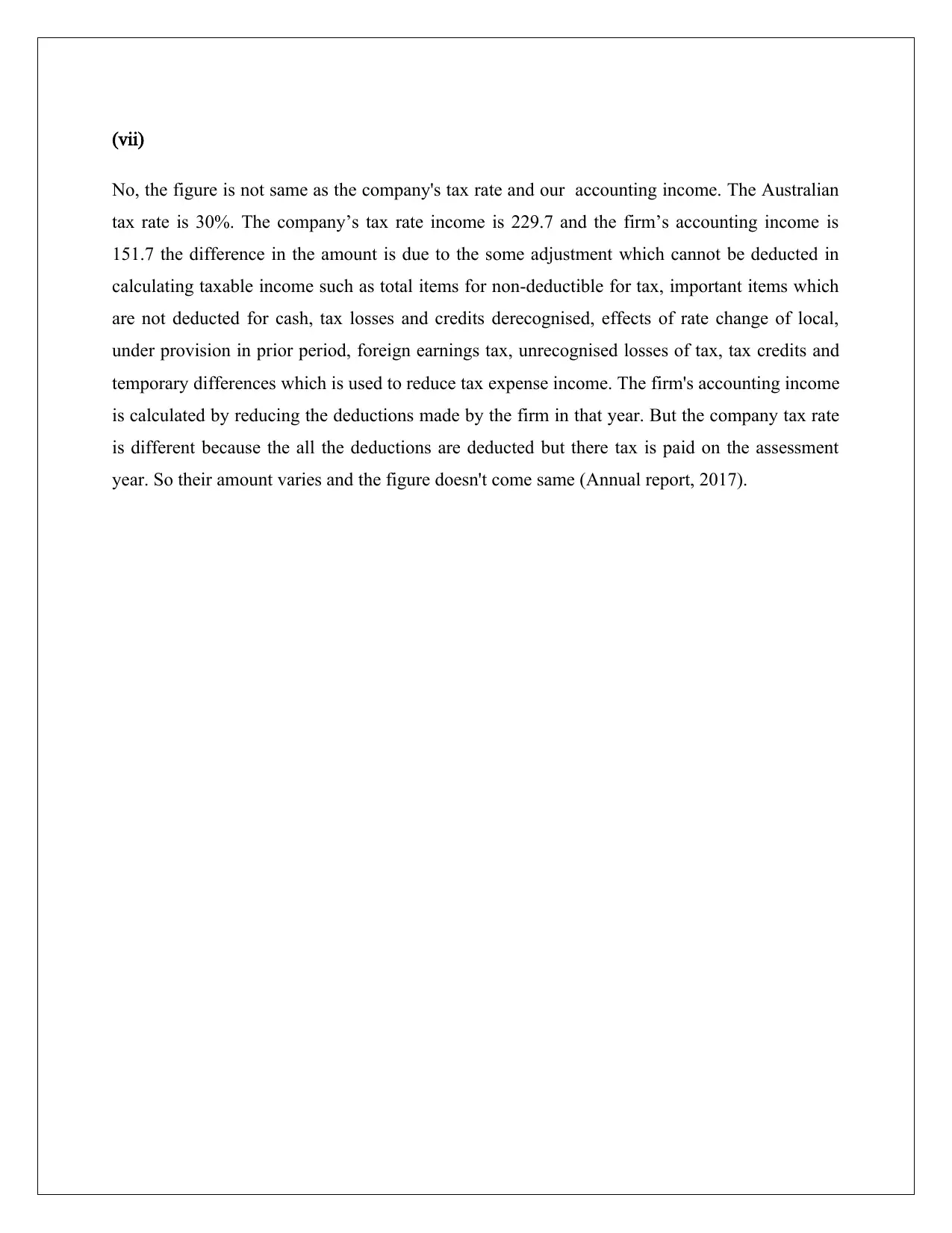
(vii)
No, the figure is not same as the company's tax rate and our accounting income. The Australian
tax rate is 30%. The company’s tax rate income is 229.7 and the firm’s accounting income is
151.7 the difference in the amount is due to the some adjustment which cannot be deducted in
calculating taxable income such as total items for non-deductible for tax, important items which
are not deducted for cash, tax losses and credits derecognised, effects of rate change of local,
under provision in prior period, foreign earnings tax, unrecognised losses of tax, tax credits and
temporary differences which is used to reduce tax expense income. The firm's accounting income
is calculated by reducing the deductions made by the firm in that year. But the company tax rate
is different because the all the deductions are deducted but there tax is paid on the assessment
year. So their amount varies and the figure doesn't come same (Annual report, 2017).
No, the figure is not same as the company's tax rate and our accounting income. The Australian
tax rate is 30%. The company’s tax rate income is 229.7 and the firm’s accounting income is
151.7 the difference in the amount is due to the some adjustment which cannot be deducted in
calculating taxable income such as total items for non-deductible for tax, important items which
are not deducted for cash, tax losses and credits derecognised, effects of rate change of local,
under provision in prior period, foreign earnings tax, unrecognised losses of tax, tax credits and
temporary differences which is used to reduce tax expense income. The firm's accounting income
is calculated by reducing the deductions made by the firm in that year. But the company tax rate
is different because the all the deductions are deducted but there tax is paid on the assessment
year. So their amount varies and the figure doesn't come same (Annual report, 2017).
Paraphrase This Document
Need a fresh take? Get an instant paraphrase of this document with our AI Paraphraser
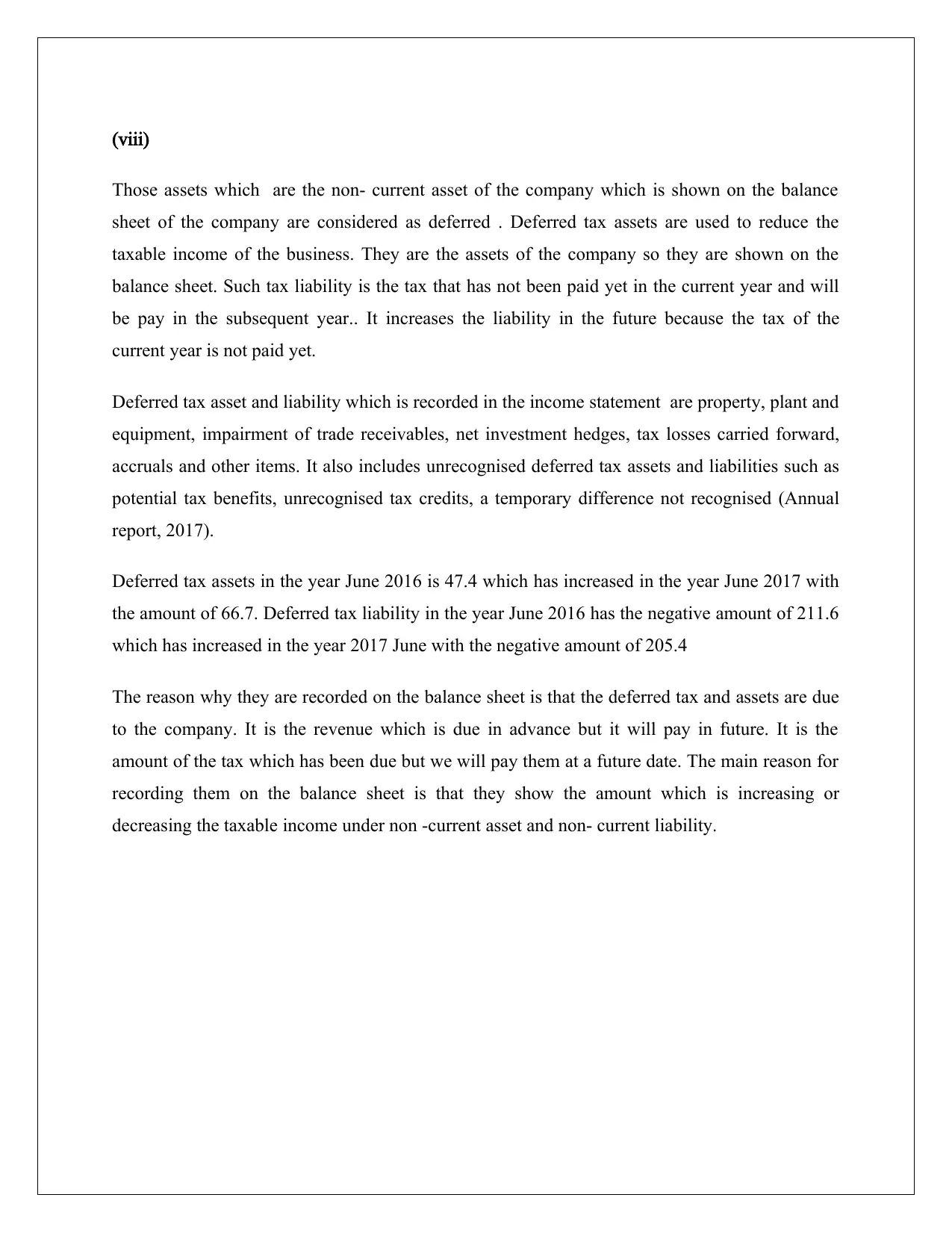
(viii)
Those assets which are the non- current asset of the company which is shown on the balance
sheet of the company are considered as deferred . Deferred tax assets are used to reduce the
taxable income of the business. They are the assets of the company so they are shown on the
balance sheet. Such tax liability is the tax that has not been paid yet in the current year and will
be pay in the subsequent year.. It increases the liability in the future because the tax of the
current year is not paid yet.
Deferred tax asset and liability which is recorded in the income statement are property, plant and
equipment, impairment of trade receivables, net investment hedges, tax losses carried forward,
accruals and other items. It also includes unrecognised deferred tax assets and liabilities such as
potential tax benefits, unrecognised tax credits, a temporary difference not recognised (Annual
report, 2017).
Deferred tax assets in the year June 2016 is 47.4 which has increased in the year June 2017 with
the amount of 66.7. Deferred tax liability in the year June 2016 has the negative amount of 211.6
which has increased in the year 2017 June with the negative amount of 205.4
The reason why they are recorded on the balance sheet is that the deferred tax and assets are due
to the company. It is the revenue which is due in advance but it will pay in future. It is the
amount of the tax which has been due but we will pay them at a future date. The main reason for
recording them on the balance sheet is that they show the amount which is increasing or
decreasing the taxable income under non -current asset and non- current liability.
Those assets which are the non- current asset of the company which is shown on the balance
sheet of the company are considered as deferred . Deferred tax assets are used to reduce the
taxable income of the business. They are the assets of the company so they are shown on the
balance sheet. Such tax liability is the tax that has not been paid yet in the current year and will
be pay in the subsequent year.. It increases the liability in the future because the tax of the
current year is not paid yet.
Deferred tax asset and liability which is recorded in the income statement are property, plant and
equipment, impairment of trade receivables, net investment hedges, tax losses carried forward,
accruals and other items. It also includes unrecognised deferred tax assets and liabilities such as
potential tax benefits, unrecognised tax credits, a temporary difference not recognised (Annual
report, 2017).
Deferred tax assets in the year June 2016 is 47.4 which has increased in the year June 2017 with
the amount of 66.7. Deferred tax liability in the year June 2016 has the negative amount of 211.6
which has increased in the year 2017 June with the negative amount of 205.4
The reason why they are recorded on the balance sheet is that the deferred tax and assets are due
to the company. It is the revenue which is due in advance but it will pay in future. It is the
amount of the tax which has been due but we will pay them at a future date. The main reason for
recording them on the balance sheet is that they show the amount which is increasing or
decreasing the taxable income under non -current asset and non- current liability.

(ix)
Yes, there is current tax assets and income tax payable recorded by our company. The current tax
asset is recorded with the amount of 66.7 and tax payable is recorded by our company is 160.2
Income tax payable is a type of current liability which is shown in the statement of income of the
year end of company. It is the amount of the taxes which are due or to pay by the company to
the government within one year. Current tax assets are Deferred tax assets which are shown in
the non- current assets of the company. The amount of income tax paid and income tax expense
is not same because the income tax payable is the tax liability of the company to pay the taxes
which are due but not paid, it will be payable in future whereas the tax expense is the charge it is
income which is generated before taxes (Annual report, 2017).
Yes, there is current tax assets and income tax payable recorded by our company. The current tax
asset is recorded with the amount of 66.7 and tax payable is recorded by our company is 160.2
Income tax payable is a type of current liability which is shown in the statement of income of the
year end of company. It is the amount of the taxes which are due or to pay by the company to
the government within one year. Current tax assets are Deferred tax assets which are shown in
the non- current assets of the company. The amount of income tax paid and income tax expense
is not same because the income tax payable is the tax liability of the company to pay the taxes
which are due but not paid, it will be payable in future whereas the tax expense is the charge it is
income which is generated before taxes (Annual report, 2017).
⊘ This is a preview!⊘
Do you want full access?
Subscribe today to unlock all pages.

Trusted by 1+ million students worldwide
1 out of 15
Related Documents
Your All-in-One AI-Powered Toolkit for Academic Success.
+13062052269
info@desklib.com
Available 24*7 on WhatsApp / Email
![[object Object]](/_next/static/media/star-bottom.7253800d.svg)
Unlock your academic potential
Copyright © 2020–2025 A2Z Services. All Rights Reserved. Developed and managed by ZUCOL.





